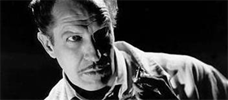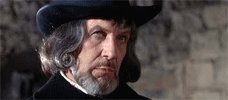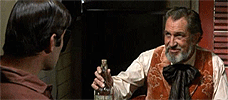Reviews
The Conquerer Worm
Michael Reeves
UK, 1968
Credits
Review by Rumsey Taylor
Posted on 07 July 2011
Source Showbox DVD
Categories Vincent Price
Witchfinder General debuted in Britain in May of 1968 and in the U.S. three months later. Both audiences had been privy to the work of the film’s masthead star, Vincent Price, who was at this time enjoying his most varied and widespread renown as a genre actor. He had appeared in horror films in both countries, most notably Roger Corman’s Poe adaptations - seven of them - in the earlier part of the decade, and had continued with a pair of Dr. Goldfoot films that endeared him to a younger demographic. Most cartoonish is his performance as the villain Egghead in the Batman television series, in which he ably contributed to that show’s unending library of puns.
None of these examples is outright frightening, and as much as Vincent Price is associated with the horror genre he’s less a monstrosity than he is a component of the decor. He had at this time entertained multiple roles that construe him as an antagonist in some regard—in Masque of the Red Death, for example (his sixth film with Corman), Price depicts the story’s hypochondriac Prospero, whose hubris results in his death as well as those in his court. His portrayal of this man, his conceit and determination to avoid death, is among his most ghastly and tragic—qualities that would be considerably more emphatic in his performance in Witchfinder General.
The film is based on a 1966 novel by Ronald Bassett that centers on Matthew Hopkins, a self-appointed witchhunter in 17th-Century Britain. Hopkins’ story is fictionalized in Bassett’s novel, but the premise is essentially true: at the time of the English Civil Wars, Hopkins rode about rural Britain with promises of dispensing with the practice of witchcraft, a practice he, with his formal experience as a lawyer, was seemingly exclusively capable of.
Price inhabits the role of Matthew Hopkins familiarly: his voice is droll and anticipatory in such a way that you think it will suddenly spring to laughter at any point, and his dramatic gate flourished in period costumes, as was the case in his Poe films. He looks, however, utterly discrepant, his womanly hair curtaining his face, sprouting from underneath a hat too queer to have been issued by the government that reportedly facilitates his diagnoses.1
Hopkins’ methodology in discovering witches is somewhat vague, because whether or not he has any interest whatsoever in witchhunting is secondary to his determination to satisfy his conceit by promoting fear. Witches, it seems, populate this environment so greatly that he deduces that a town anchored by a priest and decent economic stability must, in all probability, have a witch. He enters one called Brandeston with his assistant John, an uncouth man whose eyes pour over the women they pass, and surveys its occupants with squinted eyes. He lands upon the town’s priest and orders his men to puncture his back repeatedly in search of “the Devil’s Mark.”2
The priest is no witch, and for that matter there’s no identifiable witch in the film. Yet it is steeped in paranoia, which Hopkins has become well adept at engineering. The townsfolk believe in witchcraft insofar as there is such a thing as a witchhunter, and for a witchhunter to arrive at their humble location, so radical in his fashion and with a resolute desire to purify them, only encourages their belief. When Hopkins concentrates his nefarious intentions on one of their party they bear witness to incomprehensible violence and hear the final, pitiable screams of those they have heretofore supported and sympathized with for likely their entire lives. All the while, Hopkins’ droll countenance remains, his eyes in search of his next destination.
This paranoia is the basis of this film’s horror, and it is unrelenting. The narrative is founded upon a conflict between Hopkins and the priest’s daughter Sara, and her fiance Richard, who is a Roundhead soldier (that is, unlike Hopkins, officially endorsed by Parliament). Sara attempts to save her father by inviting the sexual interests of Hopkins in a scene both perverse and unsettling, but she fails to properly measure Hopkins’ villainy. He accepts her counteroffer, but someone in this town is doomed, for if there is no witch to be burned then he has failed in his role—a role borne purely out of exploitation.
Witchfinder General was famously the final film of director Michael Reeves, who died of his own hand the year after the film’s release. He had to his name three features, Witchfinder being the most well-regarded for its anomaly within the landscape of British horror. At this time Hammer Films had been populating cinemas with franchise sequels (Witchfinder was released in between Hammer’s third Frankenstein and Dracula sequels), and although these films are certainly of interest, they are principally derivative efforts, which constitute the bulk of Hammer’s total output. As appreciable as the best of these are, they’re more known for their atmosphere of gothicism or subversive sexuality than they are for what fear they elicit.
But it is unjust to compare Witchfinder General to the Hammer Films in its proximity, despite a title which could have christened a franchise of its own. Its cursory narrative and period setting notwithstanding, it is undistinguished by its formula but rather by its tone—a tone of quiet suspense that swells by its violent conclusion. The film is in my eyes more appropriately akin to Robin Hardy’s The Wicker Man, another British film five years its elder. Both culminate in horrific climaxes, but it is the calibrated buildup that ensures that these climaxes are all the more precipitous.
Witchfinder General ends in a medieval dungeon, within which Sara and Richard have been imprisoned. She has suffered a rape and a round of acupuncture intended to locate the Devil’s mark her late father did not sport, and Richard bears witness to this with insurmountable furor. Hopkins looks at them, relaxes his face into a pensive frown and cultivates tortures for each. In a rush of action, Richard becomes unchained, dispenses with Hopkins’ crew, and concentrates his fury on the body of his and his fiancee’s tormentor. He does so equipped with an ax, and although this final sequence is hurried, its climax - a montage that cuts between an ax raising and thrusting downward out of closeup, and the astonished faces of two Roundhead soldiers who have arrived too late to be of any assistance - is wholly unexpected in its profanity. Chomping away at Hopkins’ body long after its expiration, Richard is subdued by his fellow soldiers, who shoot Hopkins’ body in the head and make obvious its demise. “You took him from me!” Richard screams, his violence incommensurate, a truly emphatic pronouncement of the success of Hopkins’ purpose to corrupt. He is oblivious to his fiancee’s screaming, and her face is held unremittingly in closeup for one such outburst over the end credits.
- The most apt comparison I can think of in emphasizing just how incongruous Price’s Hopkins is in this film is Anton Chigurh in No Country for Old Men, another villain whose menace is relayed almost expressly in a peculiar haircut. ↩
- This is an invisible bulk, which rests beneath the skin that will resist the puncture; popping it will in theory exorcise the Devil. ↩
More Vincent Price
-

The Tingler
1959 -

The Masque of the Red Death
1964 -

The Last Man on Earth
1964 -

The Tomb of Ligeia
1964 -

War-Gods of the Deep
1965 -

Witchfinder General
1968 -

More Dead Than Alive
1969 -

The Abominable Dr. Phibes
1971 -

Dr. Phibes Rises Again!
1972 -

Theatre of Blood
1973
We don’t do comments anymore, but you may contact us here or find us on Twitter or Facebook.



